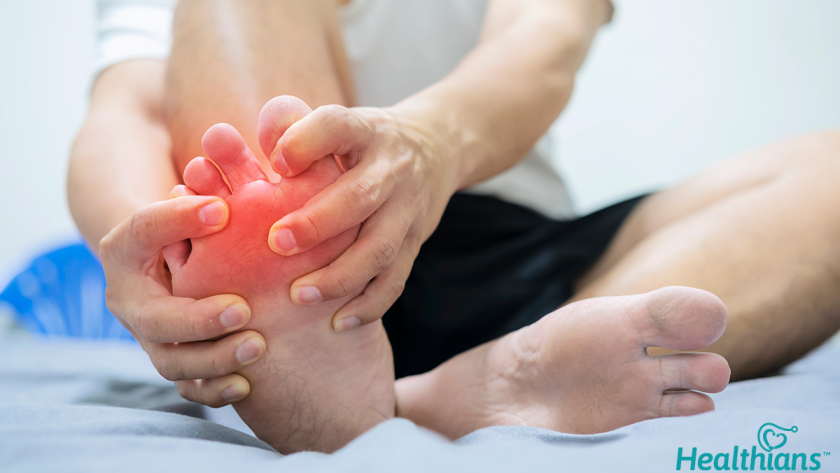[ad_1]
Contributed by: Rachana Arya
Introduction
Swelling in your lower legs, especially around your ankles and feet, is a common problem that most people encounter on an almost daily basis. The swelling can be mild or quite severe and can be a temporary occurrence or an ongoing source of pain.
To help you better understand the problem, we have pulled together the following questions and answers on this condition, its potential causes, and some of the warning flags that there may be a serious underlying issue.
Let’s begin!
FAQ #1: What is edema?
Edema — also known as fluid retention, dropsy, and hydropsy — is the medical term for swelling. It is caused by the build-up of excess fluid in your body’s tissues. Edema can affect a small part of the body or the entire body. However, it most commonly affects the lower body like hands, arms, feet, ankles, and legs due to gravity, which makes the excess fluid travel down.
FAQ #2: What does swelling caused by edema feel like?
-
- It can make the skin feel tight, or sore
- The area may feel heavy
- It can cause tingling or burning sensations around the swelling
- It can cause pain and ache in the swollen areas
- It may restrict the range of motion in the affected joints
FAQ #3: What are the signs and symptoms of edema?
Some signs of edema include:
-
- Swelling or puffiness of the skin
- Stretched skin
- Skin that retains an indent or dimple, after being pressed for several seconds
- Increased abdominal (stomach) size
FAQ #4: What causes edema?
Edema can be the result of taking certain medications, menstruation, or pregnancy. Consuming food high in sodium can make the problem worse. It may also be caused after prolonged sitting or standing, especially in hot weather. Long-haul flights, lengthy bed-rest, immobility caused by disability are also potential causes of water retention.
Edema may also be due to certain underlying causes such as:
FAQ #5: What are the easiest ways to treat edema?
-
- Take medication to remove excess fluid
- Reduce salt intake
- Elevate the legs when sitting or lying down
- Using support stockings
FAQ #6: Is exercise safe for me if I have edema?
Lack of exercise is a very common cause of water retention in the legs. Exercise can help the leg veins work against gravity to return blood to the heart. Even very small exercises can help to reduce the effects of edema.
FAQ #7: How serious is edema?
Edema can be mild and temporary. It could be a water retention problem that goes away by itself by self-care at home. However, it could also be a symptom of a serious disease that needs treatment.
FAQ# 8: Is edema hereditary?
No, you cannot catch edema from other people i.e. it’s not contagious, nor does it run in family.
FAQ #9: How is edema diagnosed?
Edema can be diagnosed by your doctor via a physical examination. The skin over the swollen area may appear stretched and shiny. Gently pushing on the swollen area for about 15 seconds will leave an indent, thus confirming edema.
FAQ #10: Can edema be prevented or avoided?
You won’t be able to prevent edema if it’s caused by a medical condition like congestive heart failure, liver disease, or renal disease; you’ll only be able to treat it. If your edema is caused by consuming too much salt, you can avoid it by following a low-salt diet.
FAQ #11: Does drinking more water help with edema?
Drinking 8 to 10 glasses of water per day can actually help reduce swelling. When the body isn’t hydrated enough, it holds onto the fluid it has, thus leading to unusual accumulation.
FAQ #12: Are bananas good for edema?
Eating potassium-rich foods does help reduce water retention in two ways. Potassium regulates the amount of water, reduces swelling, and simultaneously reduces sodium levels. Bananas, sweet potatoes, and tomatoes are examples of foods that are high in potassium.
FAQ #13: What lifestyle changes should I make if I have edema?
-
- Elevate your legs above heart level for 30 minutes three or four times per day
- Wear support stockings to put pressure on your legs to keep fluid from collecting in your legs and ankles
- Avoid sitting or standing for long durations of time without any movement
- Limit how much salt you eat
- Engage in a regular exercise regime
- Try compression stockings, sleeves, or glove
- Quit smoking
FAQ #14: Can I get rid of edema with Ayurvedic herbs?
Some Ayurvedic herbs that can help in treating the inflammation caused due to edema are:
-
- Green tea
- Ginger
- Flax seeds
- Turmeric
- Parsley
FAQ #15: What happens if edema is left untreated?
If left untreated, edema can lead to:
-
- Painful swelling
- Stiffness
- Difficulty walking
- Stretched or itchy skin
- Skin ulcers
- Scarring
- Decreased blood levels
Final thoughts
The bottom line is that most cases of edema are benign and with a few lifestyle changes you should be able to handle them on your own. However, it is recommended that you consult a doctor if your edema is persistent, worsening, or associated with symptoms like chest pain or shortness of breath. Further assessment and testing will likely involve laboratory testing of blood and possibly an echocardiogram.
Get Tested For Inflammation Today!
This post has already been read 3 times!
[ad_2]
Source link




